Abdulrahman D. S. Alhamd 1; Majid A. Ibrahim 2*
1, Date Palm Research Centre, University of Basrah, Basrah, Iraq
2, Horticulture and Landscape Department, College of Agriculture, University of Basrah, Basrah, Iraq
E-mail:
majid.abdulhameedl@uobasrah.edu.iq
Received: 28/11/2023
Acceptance: 29/01/2024
Available Online: 30/01/2024
Published: 01/07/2024

Manuscript link
http://dx.doi.org/10.30493/DAS.2024.427608
Abstract
The production of date palms in Southern Basrah, Iraq, is significantly hindered by the rising levels of salinity in the soil and water. This study explores regional and seasonal changes in soil and groundwater salinity and their impact on date palm yield, focusing on Shatt Al-Arab and Abu Al-Falous River area. During the growing season, soil and groundwater samples were collected and examined at various distances from Shatt Al-Arab (1000, 2000, 3000, and 4000m) and Abu Al-Flous River (250, 500, and 750m) on three separate occasions. The date palm yield in each examined section was quantified to assess the adverse impact of salinity on date production. The findings indicated a rise in salinity levels as the distance from Shatt Al-Arab and Abu Al-Flous River increased, with the most notable impact recorded at higher distances. The salinity of groundwater reflected the patterns of soil salinity and increased throughout the growing season. The productivity of date palm trees significantly decreased as salinity levels increased, resulting in a reduction of up to 88.67%. This study emphasizes the immediate necessity for contemporary soil and water management solutions to tackle the issues caused by salinity and maintain date palm production in Basrah Governorate.
Keywords: Date Palm, Salinity, Soil, Water, Productivity, Basrah
Introduction
Historically, Iraq has consistently ranked among the major producers of dates. Recent figures reveal a decline in the condition of date palm orchards, both in terms of the number of date trees and the quantity of production especially in Basrah Governorate [1]. The production of date palms is influenced by various elements, with soil and water characteristics being the most significant determinants. Furthermore, the combined impact of climatic circumstances has a significant role in shaping the growth and production of date palms [2].
Dates is an arboreal species characterized by an exceptional capacity to withstand high levels of salinity. They have a far higher resistance to saline compared to other fruit trees. Nevertheless, the production of the plant diminishes as the salinity in the root spreading area increases. The rise in saline levels in both the soil and irrigation water had a detrimental impact on the growth and production of the date palms. The level of salinity has a significant impact on various biological activities in plants, with the most crucial one being the process of photosynthesis [3]. A notable reduction in yield and a drop in the weight, length, and diameter of the fruits were observed when Siwi palm trees were irrigated with water containing a saline level ranging from 2.5 to 14.5 dS/m [4]. Additionally, there was a reduction in the longitudinal growth of the root and vegetative system of palm trees [5]. The detrimental impact of salts on the weight, size, and overall yield of the date fruit was also previously discussed [6].
The predominant irrigation technology employed in irrigating the majority of date palm orchards in Basrah Governorate is the tidal system. The network consists of primary, secondary, and tertiary branches that facilitate the intake of irrigation water during high tide and its withdrawal during low tide. For centuries, this strategy has shown to be an appropriate, cost-free, and effective method for irrigating date palms. Nevertheless, the decline in imports of water from neighboring countries through the Tigris and Euphrates rivers over the past twenty years has resulted in a reduction of water availability in the soil profile of palm groves in Shatt Al-Arab basin. This adversely impacted the development and productivity of palm trees, particularly in the southern region [7].
The rise in salinity in Shatt Al-Arab is a result of the drainage water flowing from the connected subsidiary canals into Shatt Al-Arab during low tide [8]. The progression of the leading edge of saline marine waters in the Gulf during high tide, and its subsequent blending with the freshwater of Shatt Al-Arab, significantly contributed to the degradation of Shatt Al-Arab’s water quality and the rise in salinity within the soil profile. This rise significantly led to the degradation of palm farming and a decrease in its production, both in terms of quantity and quality [9]. The growth and production of date palms in the southern part of Basrah Governorate are declining due to the worsening condition. The extent of this decline is influenced by the spatial variations of Shatt Al-Arab. This study aimed to evaluate the salinity levels of the soil and water in many tributaries connected to the southern portion of Shatt Al-Arab and analyze their impact on soil properties and date palm productivity in the area.
Material and Methods
Study area
The study was carried out in 2021 on an area of about 600 hectares, on the banks of Abu Al-Flous River (30°2652 N 47°5952 E), Basrah, Iraq. This river is a significant waterway in the fertile Abu Al-Khasib District, which is a branch of Shatt Al-Arab and stretches westward to the marshlands. The irrigation method utilized in these regions is the tidal system, which relies on the influx of tidal water throughout the bi-daily tidal cycle, alternating with two periods of low tide.
Initial soil and water analysis
To assess the general situation of the study area, a comprehensive sampling approach was employed to collect soil and irrigation water samples across the whole river basin, encompassing a 3 km width on both sides, utilizing a grid system. Measurements were computed for depths of 0-30 cm, 30-60 cm, and 60-90 cm. The soil samples were dried, ground, and sieved using a 2 mm diameter screen in order to assess the fundamental physical and chemical characteristics of the soil.
The pipette method was employed to estimate the size distribution of soil particles, while the Core methods were used to estimate the bulk density of the soil [10]. The electrical conductivity of the saturated soil pulp extract was determined using the WTW electrical conductivity device. The pH of the soil was measured in the soil suspension using a WTW pH meter. The amount of calcium carbonate was determined by mixing 1 g of the soil with 1 m sodium hydroxide after adding 1 m hydrochloric acid and utilizing the phenolphthalein indicator. The estimation of organic matter was conducted using the Walkely and Black method [11].
The dissolved positive and negative ions in the saturated soil paste extract were then estimated. The concentrations of calcium (Ca+2) and magnesium (Mg+2) were measured using electrophoresis with a solution of 0.01 molar Na2-EDTA. The concentration of chloride (Cl–) was determined using electrophoresis using a solution of 0.05 molar silver nitrate (AgNO3) [12]. Potassium (K+) and sodium (Na+) were quantified using a flame photometer [13], whereas sulfate (SO4-2) was measured using a spectrophotometer by the turbidity method [13]. Carbonates (CO3-2) and bicarbonates (HCO3–) contents were estimated using the decantation process using 0.01 molar sulfuric acid [14]. The results of this initial inspection are shown in Table 1.
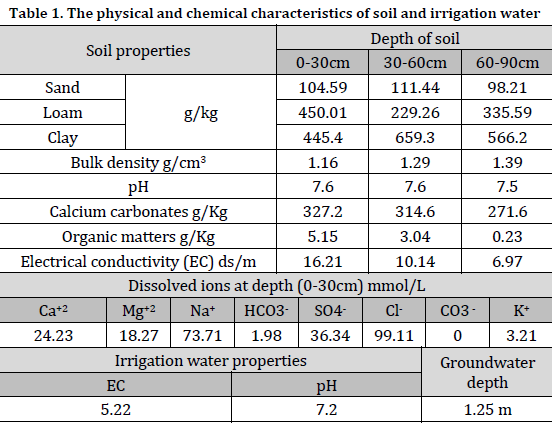
Study factors and data collection
The region stretching from Shatt Al-Arab, near Abu Al-Falous River, to its termination close to the Sabkha lands, was partitioned into four portions based on their distances from Shatt Al-Arab (D1: 1000m, D2: 2000m, D3: 3000m, and D4: 4000m from Shatt Al-Arab). Additionally, each cross-section was subdivided into secondary sectors on both banks of Abu Al-Falous River, at three different intervals (W1: 250m, W2: 500m, and W3: 750m from Abu Al-Falous River) (Fig. 1).
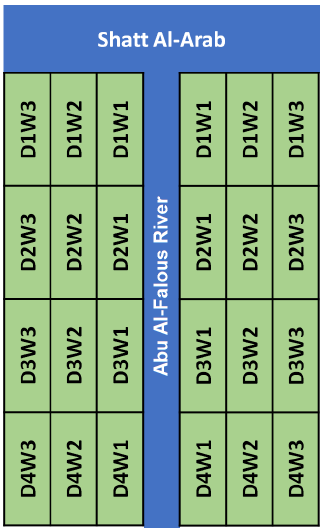
Auger wells were drilled within each of the subplots to a depth of 2 meters, reaching the lowest groundwater level. A metallic fastening was placed at the bottom of the wells. Subsequently, PVC pipes measuring 2.5 meters in length, 10 centimeters in diameter, and equipped with several holes measuring 0.3 centimeters in diameter at their base were inserted into the wells. Boulder filters were strategically placed around the pipes to optimize water flow toward the pipe and prevent any blockage of the openings. A cloth was positioned atop the pipe to promote the flow of air and inhibit the accumulation of pressure as the groundwater rises.
The depth of groundwater was routinely assessed with the wet tape measure technique [15] and groundwater samples were collected from the drilled auger wells. Simultaneously, soil samples were collected from the surrounding areas of each auger well at a depth of 0-30 cm. Groundwater and soil samples were obtained periodically every three months over the course of the initial (A), intermediate (B), and final (C) stages of the growth season. The electrical conductivity of the saturated soil pulp extract and the collected groundwater samples was determined using an EC-meter (WTW model Cond 7110) [13].
To assess the effects of salinity on the productivity of date palms in the study area, nine Hillawi palm trees were chosen in each subsection near the monitoring wells. The date palms were nearly identical in terms of their age, height, and robustness of growth. The productivity of each date palm was determined after the season by picking the fruits and measuring their weight using a standard scale.
Statistical analysis
The factorial experiment was conducted in a completely randomized design (CRD) with three replications. The data were analyzed statistically using GenStat v14 statistical software. The adjusted least significant difference (RLSD) test was used to compare the means of the studied treatments.
Results
Soil profile salinity
Spatial changes (distances from Shatt Al-Arab and Abu Al-Falous River) resulted in significant variations in soil salinity levels. The lowest soil salinity value (10.01 ds/m) was observed in the closest subplot to both rivers (D1W1). However, salinity values increased by increasing the distance from both Shatt Al-Arab and Abu Al-Falous Rivers. The most dramatic increase in soil salinity was noted at 4000 m (D4) distance from Shatt Al-Arab reaching 55.38 ds/m at W3 (750 m from Abu Al-Falous River) (Fig. 2 A).
The interaction between the distance from Shatt Al-Arab (D1, D2, D3, and D4) and the growth season periods (A, B, and C) indicated that the soil profile had the lowest salinity levels (10.35 ds/m) at the beginning of the season (D1A). On the other hand, the highest salinity level (53.36 ds/m) was observed by the end of the season at the furthest distance from Shatt Al-Arab (D4C). Regardless of the distance from Shatt Al-Arab, soil salinity appears to increase throughout the growth season; however, this increase was not significant between the intermediate and the final stages of the season (Fig. 2 C).
As for the interaction between the distance from Abu Al-Falous River (W1, W2, and W3) and the growth season periods (A, B, and C) effect on the salinity levels of the soil profile, the findings indicated that W1 sector had the lowest soil salinity value (18.51 ds/m) at the beginning of the season. On the other hand, the highest soil salinity value was observed by the end of the growth season in W3 location (33.53 ds/m). Although soil salinity increased throughout the growing season, these increases were not significant between B (intermediate) and C (final) stages of the growth season in each studied location (Fig. 2 D).
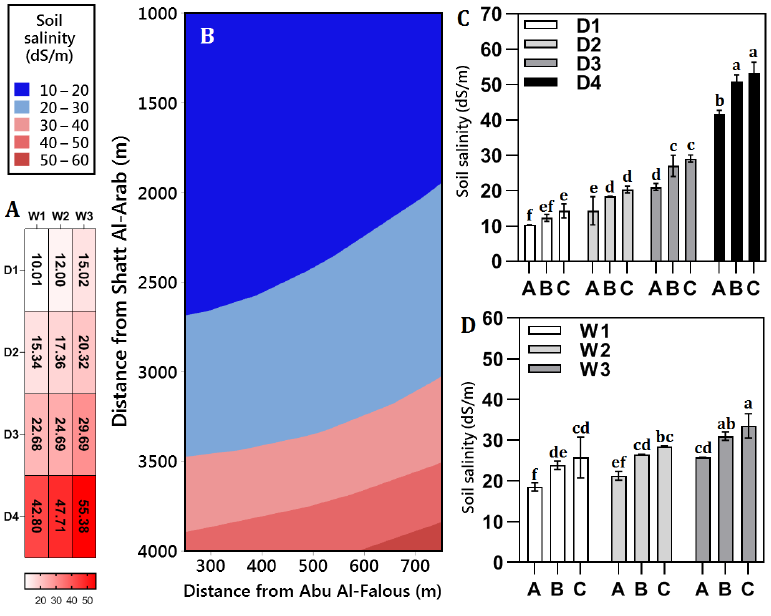
Groundwater salinity
The average groundwater salinity increased as the distance from Shatt Al-Arab and Abu Al-Falous River increased, ranging from 6.39 ds/m in D1W1 to 40.68 ds/m in D4W3. The greatest significant rise in groundwater salinity was recorded in the D4 sections (Fig. 3 A). The findings indicated that the salinity of the groundwater was influenced to a greater extent by the proximity of the sector to Shatt Al-Arab, as opposed to its proximity to Abu Al-Falous River (Fig. 3 B) for the entire duration of the growing season (Fig. 3 C and D).
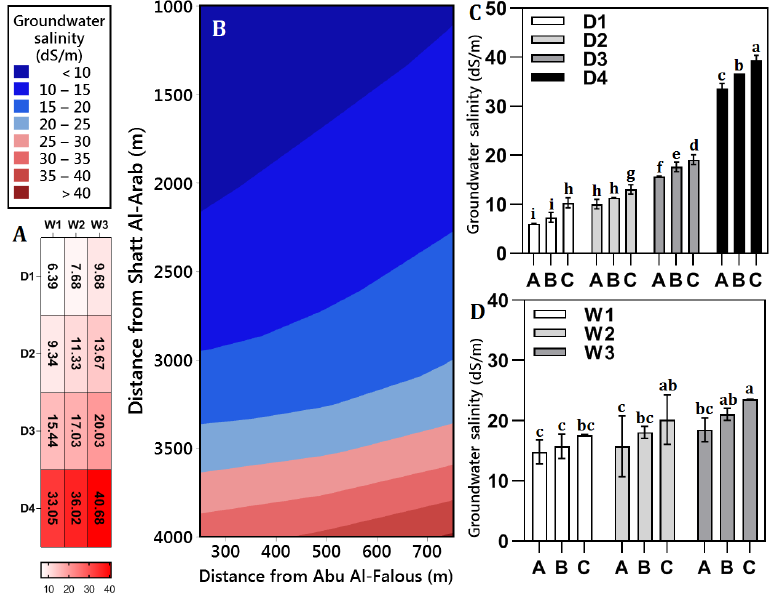
Groundwater salinity exhibited a parallel increase to soil salinity for the entire growing season (A, B, and C). The groundwater salinity levels were lowest at the start of the season in D1 (6.05 ds/m) and W1 (14.8 ds/m) locations and reached their greatest values by the conclusion of the growing season in D4 (39.36 ds/m) and W3 (23.53 ds/m) locations.
Total yield
The findings indicated notable variations in yield values as a result of the varying distances from Shatt Al-Arab and Abu Al-Falous River (Fig. 4 A). The maximum yield value was observed in the D1W1 sector, with a value of 48.95 kg/tree, whereas the minimum yield was recorded in the D4W3 sector, with a value of 5.55 kg/tree. The decline in crop production from D1W1 to D4W3 amounted to 88.67%. The combined yield of sectors D4 had a significant reduction of 86.45% compared to that of D1. Conversely, there was an 8.9% reduction in yield between W1 and W3 sectors. Hence, for every 100-meter increment from Shatt Al-Arab, there was a reduction of 2.16% in date palm yield, but the same distance from Abu Al-Falous River resulted in a fall of 1.19% in yield.
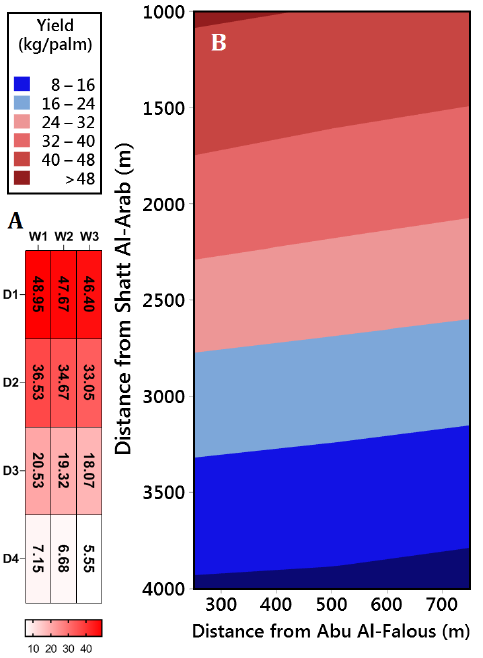
Discussion
The salinity levels of the soil and groundwater exhibited a greater increase moving away from Shatt Al-Arab, as opposed to moving away from Abu Al-Falous River. The soil salinity assessments varied from moderate to highly saline [16]. The spatial increase in soil salinity in the studied area was previously observed in Abu Al-Khasib district from the north to the south [8], in addition to the difference in the shoulders of internal rivers [17].
The increase in salinity values in the soil and groundwater with spatial and temporal change (moving away from Shatt Al-Arab and Abu Al-Falous River and with the progression of the growing season) can be attributed to several reasons. One significant factor is the ongoing use of low-quality and salty water for irrigation. This, combined with the high level of groundwater (1.15-1.50m), has led to the soil and groundwater becoming saline due to the movement of water through capillary action during the hotter months (June, July, August, and September) at the end of the growing season (C). Furthermore, there is a decline in water recharge values, which refers to the amount of soil column refilled during high tide and drained during low tide, in distant areas from Shatt Al-Arab [7]. The deposition of sediments in certain water channels impedes the drainage of surplus saltwater [18]. Consequently, the salinity levels rose in comparison to the areas along Shatt Al-Arab and Abu Al-Falous River, which experience higher rates of water recharge due to their close proximity to the tidal effect.
The current research showed that increasing soil salinity from 10.01 to 55.38 dS/m and groundwater salinity from 6.39 to 40.68 dS/m resulted in a decrease in date palm yield by 88.67%. Date palm is widely recognized for its ability to withstand high levels of salinity. However, when the soil, irrigation water, and groundwater contain excessive amounts of salt, it can have detrimental effects on the productivity of date palm trees. This is due to salinity impacting the osmotic pressure and consequent adversely affecting water and nutrients availability. Additionally, high salinity can have detrimental effects on the plant’s physiological processes, including respiration, photosynthesis, and energy transfer [19]. Furthermore, groundwater with increased salinity levels inhibits palm tree growth and reduces its production capacity [20].
In order to mitigate the detrimental impact of salinity on palm orchards in the southern region of Basrah Governorate, it is imperative to swiftly embrace alternative irrigation techniques. By implementing basin, drip, and rotational irrigation methods, it is possible to enhance the moisture levels within the effective depth of soil (the root zone between 0-60 cm). In addition, the use of modern irrigation techniques and shorter intervals between irrigation sessions may help decrease soil salinity levels at this particular depth, as opposed to the traditionally used tidal irrigation system commonly used in the region [21][22]. Thus, additional research is necessary in this field to investigate potential approaches for mitigating the negative impacts of salinity on date palm production in the region.
Conclusions
The degradation of water quality in Shatt Al-Arab and the reduction in its volume has resulted in an elevation in the concentration of salts in the groundwater, hence intensifying the process of soil salinization by capillary action. The salinity levels of soil and groundwater rise as the distance from both the Shatt Al-Arab and Abu Al-Falous River increases. The rise in salinity leads to a significant decline in date palm productivity in the region. Hence, it is imperative to implement contemporary techniques for soil and water management in order to address the issue of salinity in Basrah Governorate.
References
| 1 | Matar AM. Palm cultivation and production. Dar Al-Hekma Press, Basrah University, Iraq. 1991. |
| 2 | Al-Hamad AD, Alnajjar MA, Ibrahim MA. The effect of alternating salinity of irrigation water and cultivation level on some soil properties and growth of date palm (Phoenix dactylifera L.) offshoots of Hillawi cultivar in clay soils. Int. J. Agricult. Stat. Sci. 2021;17(1):63-72. |
| 3 | FAO. FAO statistical databases FAOSTAT. 2021 Link |
| 4 | Abdel-Nasser G, Harhash MM. Response of date palm to salinity of irrigation water under Siwa oasis conditions. In Proceedings of the Second International Conference on Date Palms, United Arab Emirates University, Al-Ain, United Arab Emirates 2001;150. |
| 5 | Ramoliya PJ, Pandey AN. Soil salinity and water status affect growth of Phoenix dactylifera seedlings. N. Z. J. Crop Hortic. Sci. 2003;31(4):345-53. DOI |
| 6 | Al-Tamimi IH. The Use of Mathematical Modeling in Prediction of date palm (Phoenix dactylifera L, cv. Hillawi) productivity as influenced by certain production factors. Ph.D. thesis, College of Agriculture, University of Basrah, Iraq. 2006. |
| 7 | Al-Fayad JMS. The effect of water recharge during the Shatt Al-Arab tides on some soil properties of palm groves and groundwater in the soil adjacent to the Hamdan River. M.Sc. thesis, College of Agriculture, University of Basrah, Iraq. 2012. |
| 8 | Hussein AA. The Prblem of Salt in Abu AL-K haseeb, its Dunser and the Way of Avoiding it. Basra Stud. J. 2014;17(1994):60-90. |
| 9 | Lateef ZQ, Al-Madhhachi AS, Sachit DE. Evaluation of water quality parameters in Shatt Al-Arab, Southern Iraq, using spatial analysis. Hydrology. 2020;7(4):79. DOI |
| 10 | Walkely A, Black TJ. Determination of organic carbon by rapid titration method. Soil Sci. 1934;37:29-35. |
| 11 | Black CA, Evans DD, White JL. Methods of soil analysis. Part 1. Physical and mineralogical methods. American Society of Agronomy, Inc. 1965. |
| 12 | Rathje. Jackson, ML: Soil chemical analysis. Verlag: Prentice Hall, Inc., Englewood Cliffs, NJ. 1958. DOI |
| 13 | Page AL, Miller RH, Keeney DR. Methods of soil analysis. Part 2. American Society of Agronomy. Soil Science Society of America, Madison, WI, USA. 1982;4(2):167-79. |
| 14 | Richards LA. Diagnosis and improvement of saline and alkali soils. US Government Printing Office. 1954. |
| 15 | Ritzema HP, Kselik RA, Chanduri F. Drainage of irrigated lands: Irrigation water management training manual. Rome: Food and Agriculture Organization of the United Nations paper number 9. 1996. |
| 16 | Al-Zubaidi AH. Soil Salinity (Theoretical and Applied Foundations). Ministry of Higher Education and Scientific Research, University of Baghdad, Iraq. 1989:308. |
| 17 | Al-Jassim KA. Natural Reasons Causing Soil Salinity and its Impact of Plant Production in Ali-Algharbi District. Iraqi J. Desert Stud. 2021;11(2):72-94. DOI |
| 18 | Kazberuk W, Szulc W, Rutkowska B. Use bottom sediment to agriculture—Effect on plant and heavy metal content in soil. Agronomy. 2021;11(6):1077. DOI |
| 19 | Hnilickova H, Kraus K, Vachova P, Hnilicka F. Salinity stress affects photosynthesis, malondialdehyde formation, and proline content in Portulaca oleracea L. Plants. 2021;10(5):845. DOI |
| 20 | Sharif AO, Sanduk M, Taleb HM. The date palm and its role in reducing soil salinity and global warming. In IV International Date Palm Conference. 2010:59-64. DOI |
| 21 | Al-Hamad ADS. The effect of interval, irrigation treatments, and soil surface coverage on some of its properties and the production of the date palm (Phoenix dactylifera L.). Ph.D. thesis, College of Agriculture, University of Basrah, Iraq. 2015. |
| 22 | Velmurugan A, Swarnam TP, Ambast SK, Kumar N. Managing waterlogging and soil salinity with a permanent raised bed and furrow system in coastal lowlands of humid tropics. Agric. Water Manag. 2016;168:56-67. DOI |
Cite this article:
Alhamd, A., Ibrahim, M. Unveiling soil and groundwater salinity dynamics and its impact on date palm yield in Southern Basrah, Iraq. DYSONA – Applied Science, 2024;5(2): 25-32. doi: 10.30493/das.2024.427608
